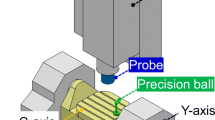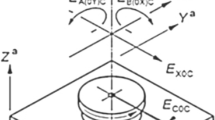Abstract
This paper presents an experimental study conducted to assess the correlation between the intra-axis errors of prismatic axes for CNC machine tools. The validity and reliability of parametric models for the modeling of intra-axis errors (IAEs) of CNC machine tools in the context of indirect calibration are also assessed in this work. Three CNC machine tools with various controllers and guidance technologies were tested using two different measuring instruments. Two predictive models, namely Bézier and B-spline curves, are described and compared for the first time in this work. Both models are experimentally evaluated for accuracy and predictive efficiency using four evaluation criteria and new data sets from the three tested CNC machine tools. Results show a strong correlation between the positioning errors and the pitch and yaw errors for all the tested machines. The results also show that both proposed models are appropriate for the modeling of intra-axis errors, with the B-spline curves coming slightly on top in terms of performance. Moreover, with the same number of control points (n = 5), the two models provide residuals that are lower than the repeatability of the machine for most intra-axis errors tested. This experimental study thus confirms that a Bézier model of degree four and a B-spline model of degree two, both with five control points, are sufficient to represent the intra-axis errors for the tested CNC machine tools.

























Similar content being viewed by others
Data availability
All data presented in this paper are available.
Code availability
Can be made available upon request.
References
Liu C, Xu X (2017) Cyber-physical machine tool – the era of machine tool 4.0. Procedia CIRP 63:70–75
Jeon B, Yoon JS, Um J, Suh SH (2020) The architecture development of Industry 4.0 compliant smart machine tool system (SMTS). J Intell Manuf 31:1837–1859
Xu X (2017) Machine Tool 4.0 for the new era of manufacturing. Int J Adv Manuf Technol 92:1893–1900
Rastegari A, Archenti A, Mobin M (2017) Condition based maintenance of machine tools: vibration monitoring of spindle units. Ann Reliab Maintain Symp (RAMS)
Fan KCh, Chen HM, Kuo TH (2012) Prediction of machining accuracy degradation of machine tools. Precis Eng Maintainability Symposium (RAMS) 36:288–298. https://doi.org/10.1109/RAM.2017.7889683
Gregory W, Vogl M (2016) Alkan Donmez, Andreas Archenti, Diagnostics for geometric performance of machine tool linear axes. CIRP Ann 65(1):377–380
de Lacalle NL, Lamikiz AL (2009) Machine tools for high performance machining. Springer, London. https://doi.org/10.1007/978-1-84800-380-4
Han Z, Jin H, Liu Y, Fu H (2013) A review of geometric error modeling and error detection for CNC machine tool. Appl Mech Mater 303–306:627–631. https://doi.org/10.4028/www.scientific.net/amm.303-306.627
Ramesh R, Mannan MA, Poo AN (2000) Error compensation in machine tools — a review Part II: thermal errors. Int J Mach Tools Manuf 40:1257–1284
Ramesh R, Mannan MA, Poo AN (2005) Tracking and contour error control in CNC servo systems. Int J Mach Tools Manuf 45(3):301–326
Lyu D, Liu Q, Liu H, Zhao W (2020) Dynamic error of CNC machine tools: a state-of-the-art review. Int J Adv Manuf Technol 106:1869–1891
Chen J-R, Ho B-L, Lee H-W, Pan S-P, Hsieh T-H (2018) Geometric error measurement of machine tools using autotracking laser interferometer. Sens Mater 30:2429–2435
Chen JS, Kou TW, Chiou SH (1999) Geometric error calibration of multi-axis machines using an auto-alignment laser interferometer. Precis Eng 23:243–252
Majda P (2012) Modeling of geometric errors of linear guideway and their influence on joint kinematic error in machine tools. Precis Eng 36:369–378
Ramesh R, Mannan M, Poo A (2000) Error compensation in machine tools—a review: part I: geometric, cutting-force induced and fixture-dependent errors. Int J Mach Tools Manuf 40:1235–1256
Bohez ELJ, Ariyajunya B, Sinlapeecheewa Ch, Shein TMM, Lap DT, Belforte G (2007) Systematic geometric rigid body error identification of 5-axis milling machines. Comput Aided Des 39(4):229–244
Khan AW, Chen W (2011) A methodology for systematic geometric error compensation in five-axis machine tools. Int J Adv Manuf Technol 53:615–628
Yu Z, Tiemin L, Xiaoqiang T (2011) Geometric error modeling of machine tools based on screw theory. Procedia Eng 24:845–849
Xing K, Achiche S, Esmaeili S, Mayer JRR (2018) Comparison of direct and indirect methods for five-axis machine tools geometric error measurement. Procedia CIRP 78:231–236
Slamani M, Mayer J, Cloutier G (2011) Modeling and experimental validation of machine tool motion errors using degree optimized polynomial including motion hysteresis. Exp Tech 35:37–44
Lee JH, Liu Y, Yang S-H (2006) Accuracy improvement of miniaturized machine tool: Geometric error modeling and compensation. Int J Mach Tools Manuf 46:1508–1516
Slamani M, Mayer R, Balazinski M (2013) Concept for the integration of geometric and servo dynamic errors for predicting volumetric errors in five-axis high-speed machine tools: an application on a XYC three-axis motion trajectory using programmed end point constraint measurements. Int J Adv Manuf Technol 65:1669–1679
Slamani M, Mayer R, Balazinski M, Zargarbashi SHH, Engin S, Lartigue C (2010) Dynamic and geometric error assessment of an XYC axis subset on five-axis high-speed machine tools using programmed end point constraint measurements. Int J Adv Manuf Technol 50:1063–1073
Aguado S, Samper D, Santolaria J, Aguilar JJ (2012) Identification strategy of error parameter in volumetric error compensation of machine tool based on laser tracker measurements. Int J Mach Tools Manuf 53:160–169
Qianjian G, Jianguo Y (2011) Application of projection pursuit regression to thermal error modeling of a CNC machine tool. Int J Adv Manuf Technol 55:623–629
Lin J, Zhang Y, Zhang X, Li W, Lin W (2018) Parametric modeling of geometric errors for CNC machine tools based on Chebyshev polynomial. In (2018) IEEE 3rd Advanced Information Technology, Electronic and Automation Control Conference (IAEAC) 2293–2297
Peng W, Xia H, Wang S, Chen X (2018) Measurement and identification of geometric errors of translational axis based on sensitivity analysis for ultra-precision machine tools. The International Journal of Advanced Manufacturing Technology 94:2905–2917
Lasemi A, Xue D, Gu P (2016) Accurate identification and compensation of geometric errors of 5-axis CNC machine tools using double ball bar. Meas Sci Technol 27(5)
Qiao Z, Hu M, Tan Z, Liu Z, Liu L, Hu W (2019) An accurate and fast method for computing offsets of high degree rational Bézier/NURBS curves with user-definable tolerance. J Comput Lang 52:1–9
Jin Y, Zhao S, Wang Y (2019) An optimal feed interpolator based on G 2 continuous Bézier curves for high-speed machining of linear tool path. Chin J Mech Eng 32:1–10
Bruni C, Mancia T, Greco L, Pieralisi M (2020) Additive manufacturing using UV polymerization of complex surfaces generated by two main B-splines. Procedia Manuf 47:1078–1083
Lin F, Shen L-Y, Yuan C-M, Mi Z (2019) Certified space curve fitting and trajectory planning for CNC machining with cubic B-splines. Comput Aided Des 106:13–29
Li J, Wang Q, Zhong G (2020) Planar tool radius compensation for CNC systems based on NURBS interpolation. Mech Ind 21:107
Msaddek EB, Bouaziz Z, Baili M, Dessein G, Akrout M (2017) Simulation of machining errors of Bspline and Cspline. Int J Adv Manuf Technol 89:3323–3330
De Santiago-Perez JJ, Osornio-Rios RA, Romero-Troncoso R, Morales-Velazquez L (2013) FPGA-based hardware CNC interpolator of Bezier, splines, B-splines and NURBS curves for industrial applications. Comput Ind Eng 66:925–932
Khan AW, Chen WA (2011) Methodology for systematic geometric error compensation in five-axis machine tools. Int J Adv Manuf Technol 53:615–628. https://doi.org/10.1007/s00170-010-2848-3
Bartoň M, Bizzarri M, Rist F, Sliusarenko O, Pottmann H (2021) Geometry and tool motion planning for curvature adapted CNC machining. ACM Trans Graph 40(4):1–16. https://doi.org/10.1145/3450626.3459837
Lartigue C, Tournier C, Ritou M, Dumur D (2004) High-performance NC for HSM by means of polynomial trajectories. Ann CIRP 53(1):317–320
Calleja A, Bo P, González H, Barton M, López de Lacalle LN (2018) Highly accurate 5-axis flank CNC machining with conical tools. Int J Adv Manuf Technol 97:1605–1615. https://doi.org/10.1007/s00170-018-2033-7
Erik LJ (2007) Bohez, Bancha Ariyajunya, Chanin Sinlapeecheewa, Tin Maung Maung Shein, Do Tien Lap, Gustavo Belforte, Systematic geometric rigid body error identification of 5-axis milling machines. Comput Aided Des 39(4):229–244
Wu B, Yin Y, Zhang Y, Luo M (2019) A new approach to geometric error modeling and compensation for a three-axis machine tool. Int J Adv Manuf Technol 102:1249–1256
Ekinci TO, Mayer JRR (2007) Relationships between straightness and angular kinematic errors in machines. Int J Mach Tools Manuf 47(12–13):1997–2004
Tang H, Duan J-A, Zhao Q (2017) A systematic approach on analyzing the relationship between straightness & angular errors and guideway surface in precise linear stage. Int J Mach Tools Manuf 120:12–19
Florussen GHJ, Delbressine FLM, Van de Molengraft MJG, Schellekens PHJ (2001) Assessing geometrical errors of multi-axis machines by three-dimensional length measurements. Measurement 30(4):241–255
Lou ZF, Fan. KC (2019) Optical sensors for machine tool metrology. In: Gao W. (eds) Metrology. Precis Manuf. Springer, Singapore. https://doi.org/10.1007/978-981-10-4912-5_4-1
Farin G (2006) Class a Bézier curves. Computer Aided Geometric Design 23:573–581
Borges CF, Pastva T (2002) Total least squares fitting of Bézier and B-spline curves to ordered data. Comput Aided Geomet Des 19:275–289
ISO 230–2 (1997) Test code for machine tools—Part 2: determination of accuracy and repeatability of positioning of numerically controlled axes. International Organization for Standardization, Geneva
Cai C, Wang G, Wen Y, Pei J, Zhu X, Zhuang W (2010) Superconducting transition temperature T c estimation for superconductors of the doped MgB 2 system using topological index via support vector regression. J Supercond Novel Magn 23:745–748
Taylor R (1990) Interpretation of the correlation coefficient: a basic review. J Diagn Med Sonogr 6:35–39
Duncan M (2005) Bézier Curves II. In applied geometry for computer graphics and CAD Springer, London. https://doi.org/10.1007/1-84628-109-1_7
Piegl LA, Tiller W (1997) The NURBS book. Springer, Berlin
Acknowledgements
The authors would like to thank Yan Boutin and Bu Khanh Vo, manufacturing engineers, for their assistance during the laboratory tests.
Author information
Authors and Affiliations
Contributions
AM was responsible for the literature study, data analysis, and writing the paper. MS was the supervisor of this work. He proposed the research idea, technical scheme, and all needed support conditions. He has also participated in data analysis and was responsible for completing the article. MZ was involved in the discussion and data analysis. RM and J-FC were involved in the discussion and significantly contributed to making the final draft of the article. All the authors read and approved the final manuscript.
Corresponding author
Ethics declarations
Ethics approval
Not applicable.
Consent to participate
All authors contribute and participate in the work carried out in this paper.
Consent for publication
The authors of this paper agree to publish this work in the International Journal of Advanced Manufacturing Technology.
Competing interests
The authors declare no competing interests.
Additional information
Publisher's note
Springer Nature remains neutral with regard to jurisdictional claims in published maps and institutional affiliations.
Appendix
Appendix
Rights and permissions
About this article
Cite this article
Mechta, A., Slamani, M., Zaoui, M. et al. Correlation assessment and modeling of intra-axis errors of prismatic axes for CNC machine tools. Int J Adv Manuf Technol 120, 5093–5115 (2022). https://doi.org/10.1007/s00170-022-09074-7
Received:
Accepted:
Published:
Issue Date:
DOI: https://doi.org/10.1007/s00170-022-09074-7




